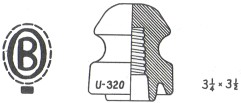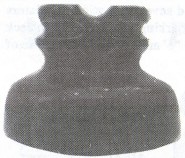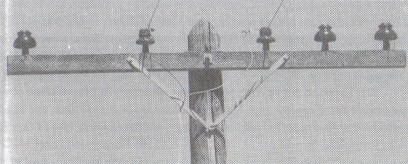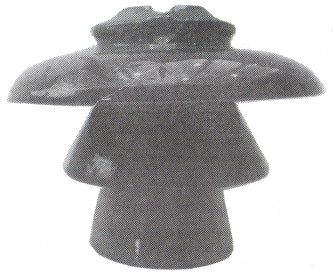Porcelain Insulator News
by Elton Gish
Reprinted from "Crown Jewels of the Wire", September 1995, page 10
Many interesting reports continue to come in as well as many that are the
result of the extensive survey of more than 30 collectors who helped with the
new porcelain insulator Value Guide. Insulator shows always produce new or
unusual items, too. You can share in the excitement of discovery by attending a
show near you. Please support your local shows and the two N.I.A. sanctioned
Regional shows and annual National show. The Marlborough National show was
FANTASTIC overall and great for porcelain, too! The next edition of Porcelain
Insulator News will feature items from Marlborough. I hope to see many of you at
the Central (London, OH) and Western Regional (Visalia, CA) shows later this
year. Now for a variety of reports.
Phil and Mona Nichols (NIA #4713/#4714) reported a couple of odd items. Their
first report is an unusual marking that most of you may not have seen before.
The incuse Findlay marking shown below (except with a “l92” instead of “l82”)
was found on a U-151 with a dark chocolate-colored glaze. This very uncommon
marking usually appears with various three-digit catalog numbers and was shown
on page 116 in Jack Tod’s book, Porcelain Insulator Guide Book. Phil and Mona
said they found the insulator along the Union Pacific Railroad right-of-way in
Kansas where all of the poles and wires had been taken down about a year
earlier.

I have never seen a Findlay catalog and would appreciate a Xerox copy for my
research files. Please contact me if you have one.
The second unusual item Phil and Mona reported was an Ohio Brass U-320 with
an odd glaze color. They found several identical insulators marked with the #5
O-B recess-embossed marking (on page 134 in Jack Tod’s book) on the skirt and
the incuse date “6' and ’78" on either side of the bar below the O-B.

Phil and Mona sent me a piece of a broken U-320 so I could see the unique
color firsthand. It is impossible to accurately describe the color, but I will
make an attempt. The color could be described as tan by many people outside the
hobby, but it is not the light shade of slightly reddish-tone tan so common on
Fred Locke and other early insulators. Rather it is a uniform brown-toned tan.
The color density could be described as medium which produces a lighter shade on
the raised parts of the marking and a darker shade in the recesses. Maybe the
color could be best described as light chocolate. It is different than anything
I have seen on a porcelain insulator.
I love going to insulator shows because something new always turns up. The
Denver show this past May was no exception. If you have a copy of my new book,
Value Guide for Unipart and Multipart Porcelain Insulator, you will see U-411
listed as “unknown”. This means that no specimens of this style have been
reported. Jack Tod made the U-Chart drawing based on a drawing he found in the
1916 Locke catalog. Oddly, U-411 was not shown in the 1919 Locke catalog. A fine
specimen of U-411 was brought to the show by Mike Miller (NIA #4622) who said
that he found it on a Denver line sometime before 1972. The glaze is a dark
mahogany color more typical of the glaze used by Franklin Porcelain Co. I
thought the insulator looked odd, but Mark Miner (NIA #4846) had a keener eye,
and he quickly added it to his collection. Please let me know if another U-411
is sitting on your shelf. Hopefully one can be found with a marking.
Until I started surveying porcelain collectors in preparation for the Value
Guide for Unipart and Multipart Porcelain Insulators, the special two-groove
cable-top styles represented by U-410A (Lapp), U-411 (Locke), U-412 (Porcelain
Products), U-412A (Franklin Porcelain), and U-412B (Pinco) were all listed as
“unknown” - no specimens known - and all but one were based on drawings from
catalogs. Pittsburg’s version, U-410, is known, but there are probably no more
than a dozen specimens in collections. Now only U-410A and U-412B remain to be
reported.

Previously unknown style, U-411,
cataloged by Locke in 1916.
U-410A was taken from a drawing in Lapp’s files dated “10-21-21”.
The only copy of a Franklin Porcelain Co. catalog that I have seen is an old
Xerox copy in Jack Tod’s files dated January 1928. This catalog shows that
Franklin Porcelain’s version of this basic style was U-412A, so I doubt that
they also made U-411 even though the glaze color might be a little odd for
Locke. U-412A is a very uncommon style, too. Ken Willick (NIA #3709) first
reported having a U-412A. Then Bill Rohde (NIA #1219) sent photographs of
several U-412A’s still on poles in eastern Washington. One of Bill’s
photographs (shown here) show two U-412A’s used to deadend small conductors by
wrapping the wire around the top side-groove. Drop leads from each insulator run
down the pole. Bill said the glaze color was pumpkin similar to Lapp products.
The Franklin Porcelain Co. catalog states that U-412A was for line voltages not
exceeding 7500 volts and further comments that “They are of the two groove
type, used for special purposes on distribution lines.” Robin Harrison (NIA
#1309) just reported getting a reddish brown U-412A. His insulator is marked ‘FP’
which confirms these were made by Franklin Porcelain. Robin’s insulator came
from Washington state and may have come from the same line Bill observed.


Photograph showing two U-412A’s in eastern Washington
state which are used to dead-end two conductors and with
drop leads running down the pole.
Two unmarked U-412’s were recently reported by Bob Stahr (NIA #4186). This
is Porcelain Products’ version of the two-groove cable-top style; however, Bob
reports that the glaze looks more like a Thomas product. The color is dark
mahogany with some dark orange coloration around the wire grooves. Porcelain
Product glazes tend to be chocolate brown. Bob said the two insulators came from
a collection in Pennsylvania.
Mike Miller brought another much more interesting insulator (at least to
classic porcelain collectors like myself) to the Denver show. It is a new style
of Fred Locke multipart!! I have assigned it M-3710. The insulator is unmarked;
however, Mike said that he found pieces of the same insulator along the old
power line which did have one of the Fred Locke multiple patent date markings on
the top skirt. Mike found this specimen of M-3710 (with beautiful two-tone top
skirt) along the same line from the Skagway, CO power plant to Pueblo, CO where
the famous all glass Locke 25’s (CD 342) were installed in 1901. Evidently the
M-3710’s were used to replace the fragile CD 342’s which began to fall
within a year of installation. The glass apparently had internal stresses which
caused them to “explode” and otherwise self-destruct. It is doubtful that
many other M-3710’s will be recovered from this line since the terrain is
extremely rugged and remote. The guys who explored part of this line recently
said they were lucky to get out alive much less carry out insulators.

M-3710 No Name Fred Locke
| 